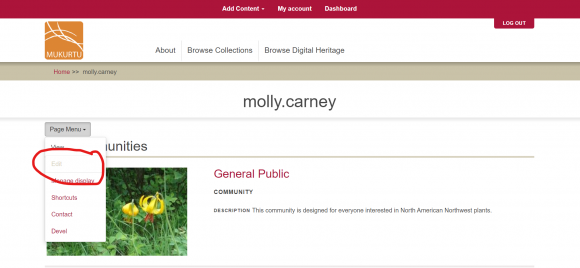If your question does not appear here, please reach out to our administators at admin@nwnativeplants.org. For general questions about Mukurtu, please see the support page - many answers to common questions are also available here.
What is an ethnobotanical digital heritage item?
Digital heritage items are online records of either tangible or intangible cultural materials. These items are flexible and could be many things such as an image, video, document, file, etc., but all include additional digital metadata documenting and describing the “item” online. Our digital heritage items are primarily digital records of plant taxa, with accompanying images, cultural narratives, information on habitats, and additional links to outside resources.
For more information, please see this Mukurtu Moment.
How do I change my password?
If you've either forgotten your password, you can edit that information in several ways. This Mukurtu Moment video offers several options for resetting passwords.
If you know your password and wish to change it, you can login to the site and click on your username or the My account button on the top crimson bar. Then, in the drop down menu associated with the Page Menu (see image below), click Edit to make changes to both your profile and password.

edit_profile.png, by molly.carney
Can I change details in my personal profile?
Yes - navigate to your account by either clicking on your name or going to Account at the top red bar. Click this link, then select Page Menu on the left hand side, and finally select Edit (see above image).
How do I join a specific cultural protocol?
To take a closer look at cultural protocols, you can visit digital heritage items (here, plant species), and look to the associated protocols visible in the right hand columns. Then, click on a protocol you are interested in. This will take you to the main page for that protocol, where you can learn more about the protocol, see who is a member, and view recent digital heritage activity.
To join a protocol, please contact the group manager or protocol stewards by clicking on their name in the member list, clicking the Page Menu, and selecting Contact from the drop down list. Here, you can reach out to that member to request access. Emails are hidden by default to protect user privacy.

contact_members.png, by molly.carney
How do I see which protocols I am a member of?
Click on either your account name or go to Account on the top red bar, select the drop down arrow, and your protocols should be listed. From here, you can navigate to the main pages for those protocols.
Can I request additional communities and cultural protocols?
Absolutely! Please contact the NWNP administrators and we can accomodate your requests by creating new communities and protocols, appointing new stewards and contributors, and finding solutions that work well for your needs.
How do I create ethnobotanical digital heritage items?
If you'd like to create a new digital heritage item pertaining to a plant taxa growing in the greater Northwest, you can begin this process by selecting Add Content and then + Digital Heritage from the top bar on your screen. This Mukurtu Moment video provides a general explanation of the process; for a NWNP-specific workflow, please reach out to our administrators at admin@nwnativeplants.org.
I'd like to help move the paleoethnobotanical digital reference library to the NWNP website and/or contribute my own digital reference materials. How can I join?
We'd love to have you! Please reach out to our site administrators at admin@nwnativeplants.org to join our working group, where you will have access to our documents, workflows, and step-by-step support for moving reference collections online.
I'm interested in learning how to forage and prepare some of these plant foods.
First, always be completely positive you've identified a plant correctly! We reccomend finding a mentor or elder who can help you learn plants. There are some good resources available for the PNW, including Pacific Northwest Foraging, Food Plants of Interior First Peoples and Coastal First Peoples, and Plants of the Pacific Northwest Coast and the Inland Northwest. Secondly, please follow the principles of the grateful harvest. And finally, please know that the specific preparation methods for many of these foods are sacred knowledge for many communities.
